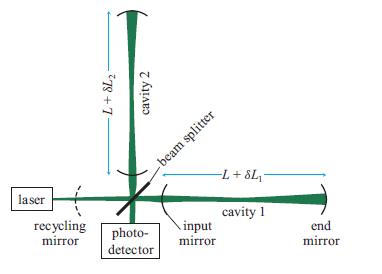Question: Simplify the analysis by treating each Gaussian light beam as though it were a plane wave. The answers for the phase shifts will be the
Simplify the analysis by treating each Gaussian light beam as though it were a plane wave. The answers for the phase shifts will be the same as for a true Gaussian beam, because on the optic axis, the Gaussian beam’s phase [Eq. (8.40a) with ω̅ = 0] is the same as that of a plane wave, except for the Gouy phase tan−1(z/z0), which is very slowly changing and thus is irrelevant.
(a) For the interferometric gravitational-wave detector depicted in Fig. 9.13 (with the arms’ input mirrors having amplitude reflectivities ri close to unity and the end mirrors idealized as perfectly reflecting), analyze the light propagation in cavity 1 by the same techniques as used for an etalon in Sec. 9.4.1. Show that, if ψi1 is the light field impinging on the input mirror, then the total reflected light field ψr1 is

(b) From this, infer that the reflected flux |ψr1|2 is identical to the cavity’s input flux |ψi1|2, as it must be, since no light can emerge through the perfectly reflecting end mirror.
(c) The arm cavity is operated on resonance, so φ1 is an integer multiple of 2π. From Eq. (9.52a) infer that (up to fractional errors of order 1− ri) a change δL1 in the length of cavity 1 produces a change

With slightly different notation, this is Eq. (9.47), which we used in the text’s order-of-magnitude analysis of LIGO’s sensitivity.
Eq. (8.40a)

Eq. (9.47)

Fig. 9.13

Vr= eig1-te-i9 1 - teigi -V, where = 2k L. 91 (9.52a)
Step by Step Solution
3.33 Rating (159 Votes )
There are 3 Steps involved in it
a Analysis of Light Propagation in the Cavity We start by analyzing the light propagation in cavity 1 using the techniques for an etalon The etalon or ... View full answer

Get step-by-step solutions from verified subject matter experts


